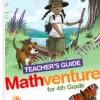Take a look inside 5 images
Mathventure for 4th Grade
Pros: Lessons cover many foundational math skills with a lot of interactivity and reinforcement.
Cons: Students can't receive feedback or track progress.
Bottom Line: Thoughtfully presented content challenges students to think critically about the material, but having so few features limit the experience.
Use Mathventure for 4th Grade as a supplemental resource; it has plenty of instructional content, but there's minimal feedback. Teacher support is highly recommended, especially for students who are just learning the concepts. Introduce a topic by having students work through a few activities on their own, and ask them to record their quiz scores so they can track their learning progress. Discuss the activities as a class, and have students revisit the activities after they're more comfortable with the concepts. Have students try the quizzes again and compare the scores to their previous attempts. Use the Problem Solving Themes chapter throughout the year to challenge students to think critically and apply their skills to real-world problems.
Mathventure for 4th Grade is an e-book series of math lessons organized into four chapters: Problem Solving Themes, Operations and Algebraic Thinking, Fractions, and Geometry and Measurement. The Problem Solving Themes chapter includes five themes, with several problems for each theme. Let's Celebrate has four party-themed problems that cover a variety of fourth-grade skills. The other three chapters include several activities with animations, audio-supported learning extensions, and follow-up quizzes.
There's a lot to learn in Mathventure for 4th Grade. Students can practice a range of math skills, and the lessons align to several (but not all) Common Core State Standards. There's nice support built in, too: As students move through the chapter activities, they can click on a button to learn more about the concept, and a "learn more" option includes audio instruction and animations. Plus, some of the activities allow students to enter answers or partial solutions, making for some nice interactivity.
Many activities don't provide students with an opportunity to actually solve problems until they get to the quizzes, however. The quizzes are scored, but hints and detailed feedback aren't provided, and scores can't be saved. As it is, this is a pretty passive learning experience.














